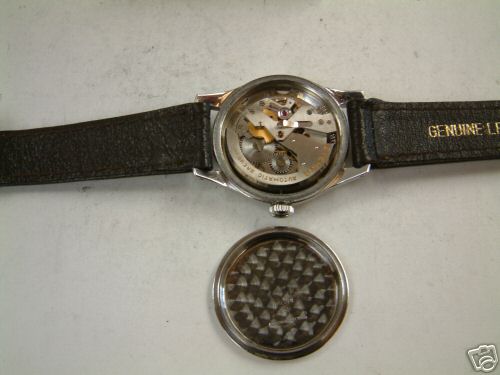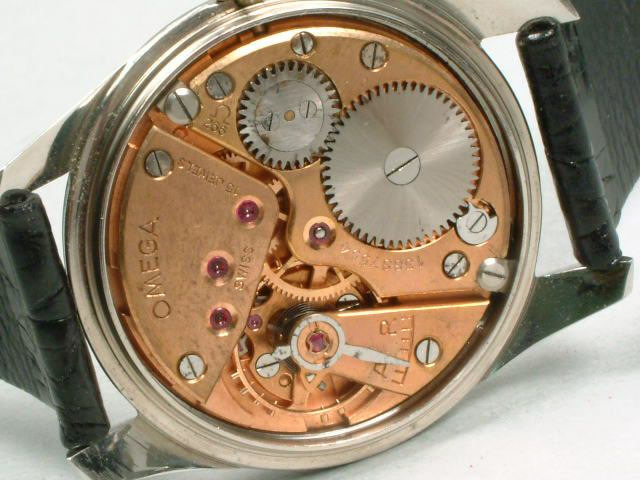

Click to view advice from other TimeZoners
Some tips on purchasing vintage watches at auction.
It always pays to be careful when purchasing vintage wristwatches or pocketwatches over the Internet, particularly in eBay auctions. Here are tips on avoiding some common scams and pitfalls.
There is reason for being cautious when buying vintage watches sight unseen. There are LOTS of talented people out there who can detail a case or redial a watch in order to make it look good for sale. Some sellers will go so far as to purchase an old watch box, put the restored watch inside, and then proclaim it to be "new old stock" or "Mint in box!" Or worse yet, "minty."
But here is the problem. Even if a watch looks good on the outside, the watch will never really be "nice" if the case and movement are in poor shape, no matter how much repair work you eventually put into it.
Watches with mechanical problems or internal damage typically end up getting resold at a loss, or consigned to the back of a sock drawer, since they won't keep time or need significant amounts of work. I should know -- I made this mistake once or twice myself.
So personally, my first rule is to ALWAYS try to get a picture of the movement and the inside of the case from the seller (as well as pictures of the case back, if this is at all possible). The condition of the INSIDE of a watch speaks volumes about a watch's past treatment and its real value.
Some sellers will genuinely be unable to show you pictures of the movement or the inside of the case because they don't have the tools and aren't watch experts. If this is REALLY the situation, and if the seller genuinely doesn't seem to know they are doing, don't force the issue. An inexperienced person may damage the watch trying to get it open with needle-nose pliers, a knife edge, or a cheap case-opening tool. But someone who auctions lots of vintage watches and boasts that the watches have been cleaned and overhauled should be able to do this without problem. If they won't ... it is worth wondering why. Be careful.
When looking at the movement, check for surface discoloration on the movement plates, or blotches, or corrosion, or parts that don't match in color (i.e., like a shiny new looking piece in the middle of an otherwise discolored movement -- which can indicate parts swapping). Look for screw heads where the slots are mangled or stretched - that shows sloppy, careless servicing work. Also look for scratches, dings, gouges, etc. -- which again indicate rough handling, or a movement that was sitting around in a watchmaker's parts drawer for years.
When looking at a case, check for corrosion on the inside of the case. Look for signs of corrosion or flecks of rust both inside the case and in the area where the caseback screws on or snaps on to the main body of the case. In particular, if it is a screw-back case, check for spots of corrosion inside the threading. All of this is telling about whether a vintage watch was being properly maintained while it was being worn on someone's wrist.
When looking at the caseback, see what sort of condition it is in, and whether it has any serious scratches, dings or gouges. Also check whether the caseback has been heavily polished (which some sellers do, to remove inscriptions or damage), or given a rough "grained" finish with a high-speed polishing tool (which is inauthentic and annoying). The condition of the caseback should NOT be a deal killer, provided that it still does its job of sealing the case. But its condition DOES effect the value of the watch. Combined with other signs, like a poorly repainted dial and a dirty movement, the caseback condition can be an indicator that the seller is just a hack, looking to make a quick buck by dressing up an otherwise tired and beat-up watch.
Here is a decent auction photo of a vintage watch I recently purchased from a good seller (a 1940's Eterna bumper automatic, in this case).

(photo by bokonon)
The photo isn't huge, but it hides nothing, and shows that this particular watch is in pretty darned good condition, with no visible issues or signs of abuse. As it turned out, this watch really was in extremely good mechanical condition -- aside from needing a cleaning and oiling, due to years of disuse.
In contrast, here is the seller's photo of an Omega watch that I purchased several years ago.

(photo by bokonon)
The problems visible in this photo are subtle. The movement isn't in BAD shape, but it has clearly been exposed to moisture. See the discoloration here and there on the plated and steel parts?
Also, see the condition of some of the screw heads? The rust spots? The slots on the screws? It has clearly been around the block.
These sorts of things aren't deal killers, but they are signs that the watch has been well-used, and may not be as pristine or "minty" as the seller is claiming.
In the case of this Omega, I ended up getting this watch anyway, since the price was right. Then I sank about $150 into repairs into it. When I took it to my watchmaker, it turned out that the movement did need some work. But I ended up with a good watch for a fair price overall. And I was happy with the experience because I didn't overpay.
Several more things:
(1) Check to see if the seller offers a money back guarantee. It is usually a sign of confidence and integrity if they do.
(2) Even if an auctioneer tells you a vintage watch has recently been overhauled or is "running perfectly," assume that ANY vintage watch that you buy online will need to be overhauled, cleaned and oiled -- at a price of about $100 to $150. Consider this to be a hidden premium which needs to be added to the purchase price.
(3) Don't fall in love with any one vintage watch. Educate yourself about what to look for before bidding -- such as signs of wear and tear, authenticity vs. inauthenticity, and typical selling prices. Then bid realistically. And know when to quit bidding. Because if you wait long enough, you'll usually see the same sort of watch come up again, perhaps several months later, sometimes at a lower price, and sometimes in better condition.
(4) Beware of artfully blurry photographs, since auction photographs are your only true guide to what you are buying.
(5) Don't make excuses or rationalize a watch that doesn't seem right. When in doubt, wait for a better one to come along.
Cheers!

Click to return to the TimeZone Vintage Forum.